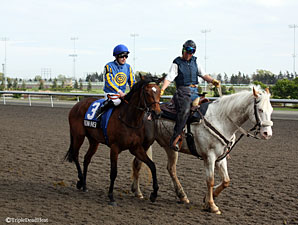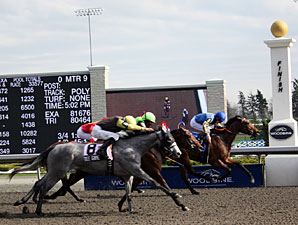By Keith McCalmont
Carolyn Costigan, conditioner of Woodbine Oaks contender Roan Inish, is a certified student of the training game.
As a graduate of the Darley Flying Start Program, Costigan travelled the world while learning the business under the tutelage of such well-regarded horsemen as Kiaran McLaughlin in New York, Lee Freedman in Australia and Mike de Kock in Dubai. Costigan parlayed a stint in the Irish National Stud Management Program along with her valuable time spent at Windfields Farm breaking and starting yearlings under saddle, tack and rider to meet the standard of the highly sought after Darley course of which only a dozen students are selected annually.
That the Irish-born Costigan has Canadian influence in her past performances should not come as a surprise.
Her family, who has owned and raced thoroughbreds since 1985, provided Woodbine patrons with an abundance of thrills in 2006 when their filly Arravale earned top honours as Canada’s Horse of the Year.
And though it might seem Costigan had an edge in the business, her start came later than most.
“We didn’t have our first horse till I was thirteen or fourteen,” said Costigan during a recent backstretch visit. “And I never sat on a horse until I was nineteen and at that it was just a lesson once a week. I had a horse off the track but he really wasn’t saddle trained.”
 Post schooling and a subsequent two-year period as an assistant trainer to Jim Bolger in Ireland, Costigan moved to Woodbine last season to train under the Arravale Racing banner. Roan Inish who had made three turf starts in Ireland under the guidance of Bolger joined Costigan on her journey. And what a stunning debut she would make as Roan Inish, with Irish jockey David Moran aboard, captured the $250K Princess Elizabeth Stakes defeating the excellent Resentless in the process.
Post schooling and a subsequent two-year period as an assistant trainer to Jim Bolger in Ireland, Costigan moved to Woodbine last season to train under the Arravale Racing banner. Roan Inish who had made three turf starts in Ireland under the guidance of Bolger joined Costigan on her journey. And what a stunning debut she would make as Roan Inish, with Irish jockey David Moran aboard, captured the $250K Princess Elizabeth Stakes defeating the excellent Resentless in the process.
Although Moran returns to Woodbine to pilot Roan Inish in races, it is Costigan who gallops her star filly each morning. It is a skill she attributes to her time spent overseas.
“Riding at Jim Bolger’s, if you don’t learn something new every hour you’re not paying attention and you won’t last,” gleamed Costigan. “You’re constantly learning about horses and what they can and can’t take. I was riding horses every morning there with everybody yelling at you, telling you what to do. You didn’t have a choice but to come out of there knowing what to do.”
With that valuable experience came a bounty of brilliant advice.
“One time Jim went to leg me up and I’d come off a couple times that week as I was just learning,” recalled Costigan with a laugh. “And he told me I had to develop a greater aversion to the ground.”
* * *
Given the breadth of her racing experience on a number of continents, it’s not a surprise that Costigan trains differently than most. Where others might lean towards a steady diet of racing experience, Costigan seems content to gallop and train her way to the desired destination.
“We may just go straight to the Oaks,” lilted Costigan. “It depends how she’s going. I’m riding her every day and that’s hugely beneficial when you have the point of view from between their ears. That’s the best point of view.”
As well spoken as she is schooled, to hear Costigan speak is akin to watching her star pupil run. Most every attempt starts slow and considered only to come galloping to swift conclusion. Her accent spills over as she discussed the differences in riding in Europe versus North America and why she’s held onto Moran as jockey.
“There’s a lot more hands and heels and a lot more action with reins,” stated Costigan earnestly. “European riders don’t tie their reins up so tight so there’s less of the handlebar action. In Europe there’s a lot of changing reins through the hands and a lot of picking up a horse before they go to the whip. There’s a lot of hands and heels before they go to the whip. That’s what she (Roan Inish) was used to and I didn’t want to start over with a different style of riding for her first race in North America.”
Given the success of that first start, it’s no surprise that Moran returns for mounts aboard Roan Inish.
“David has committed to coming out for the big races,” said Costigan. And then with an eye to the heavens added, “So please God the filly stays sound he’ll be coming over to ride her.”
Roan Inish was a late rallying second in her 2010 debut in the Fury Stakes won by her old foe Resentless. Roan Inish was seventh in the field of eight early on and slowly picked off runners around the far turn while making a run along the rail earning place money in the last jump.
Costigan appreciated her jock’s efforts.
 “For him to be flying out here and immediately after the race jumping on the plane an hour later is outstanding,” said Costigan. “He was race riding the following day in Ireland and had two winners at Gowran Park.”
“For him to be flying out here and immediately after the race jumping on the plane an hour later is outstanding,” said Costigan. “He was race riding the following day in Ireland and had two winners at Gowran Park.”
The conditioner was even more appreciative of the efforts of Resentless.
“I though the winner ran a huge race,” she exalted. “I think even in an open race we would have seen the same result. That horse was going to win that race, she was very impressive.”
But the competitive fire returned a moment later.
“We’ll definitely be trying to stretch her out for the Oaks,” smiled Costigan. “She’s a lovely filly and we’d be happy to take our chances against her again at a longer distance with a couple more furlongs. I know my horse has stamina and that she’ll grind it out and gut it out until the end. She’s got a competitive will and those things all combined you go for a longer trip and you feel a bit more confident.”
***
The stricken Resentless may not make the Oaks, but a new frontrunner has arrived at Woodbine in the form of Embur’s Song. The Todd Pletcher trained filly has notched consecutive wins to start her career earning Beyer speed ratings in the upper 90s.
Fares Farm, Inc., owns this new contender, which is ironically where Roan Inish spent her winter.
“I had her in California initially when we left Woodbine and then she was sent down to Fares Farms in Kentucky to Shannon White and she took care of her,” explained Costigan. “She had some paddock time and time off and was there for all of December and on the fourth of January she came out to me in California. When she came out to me she was a teddy bear, she had a pretty thick coat on her in Kentucky but she’s lost all that and she looks well now. She has a fine coat on her. The winter in California did her well. She had a good couple months with no tack on her just chilling out. She’s quite happy.”
With patience and perseverance, Costigan continues to see the lighter side of training her star horse and responds buoyantly to the query of would her filly try the boys in the mile and a quarter Queen’s Plate.
“Distance isn’t the issue,” began Costigan. “You take each day one at a time with horses. In this business, twenty-four hours is a long time. A girl that worked with me in California told me an old quote ‘horses are like strawberries, they go bad overnight.’ So, I take one day at a time with every horse. The Oaks is the target as she’s a filly.”
Under slight urging, Costigan continued, “She was bred with the Oaks in mind but I wouldn’t be afraid to take on those boys at that distance taking a bit of weight off of her. And if she came out of the Oaks in good form, feeling good about herself and the key is how she’s moving underneath me then we’ll go.”
***
With so much of the racing media consumed by the possibly faltering future of the sport, the up-and-coming trainer might well be a good place for writers to focus some positive attention. Not only does Costigan maintain an efficiently updated racing website, the trainer is also active on Twitter.
“When I was in the Darley Flying Start course one of the main themes recurring in the business was lack of youth - - kids under eighteen and the lack of interest racing holds for them” started Costigan. “Kids are spending all their time in front of a computer these days. They’re just being social really. They have access and are looking for information. At the end of the day young people love horses and if you can provide them with free info about horses I think that’s a winning combination.”
Up next for the hands on trainer will be both a webcam and helmet cam to provide the public with a better look into life on shed row.
“I did a report at Darley on how to attract the next generation to the racing industry and the key thing was access through the Internet,” said Costigan. “I’ll have a live webcam soon so that hopefully if she (Roan Inish) is who we think she is you can look in on her whenever you like. People just want to have access to see them and know what they are doing day-to-day. So we'll start with a webcam and then the helmet cam so you can see some works from the point of view of the rider.”
It is encouraging to spend some time with a trainer who “gets” this new generation of tech savvy racing fans even if her first try at helmet cam technology went a bit awry.
“I ended up with sixteen minutes of footage of ears,” laughed Costigan by the rail this past weekend. “We’ll try again soon.” And so will Roan Inish who, win or lose, is a safe bet to be the most thoroughly prepared horse in the Oaks - - and possibly the Queen’s Plate.
* * *
Keep up-to-date with Costigan and Roan Inish on the Arravale Racing website and via Twitter at http://twitter.com/arravaleracing.




